 Evolution
Evolution
Ediacarans Are Not Animals

Editor’s note: We are delighted to present here Part 2 of “A Precambrian House of Cards,” a series by Dr. Bechly. Find the full series at this link. An extensive References section will follow at the end of the series.
Apart from Kimberella, there is no convincing evidence that the organisms studied by Evans et al. (2021) either represent Ediacaran animals at all, or belong to the attributed subgroups of the animal kingdom, as I have documented in my article series at length and in great detail (Bechly 2018, 2020 a, b, c, d, e, f, 2021 a, b). Dickinsonia is most likely not an animal and definitely has no bilateral symmetry but typical Ediacaran glide symmetry (Bechly 2018), Ikaria is a totally useless fossil that could be a protist or a coelenterate (Bechly 2020b), and even Kimberella remains a problematic organism that could be anything including a coelenterate-grade animal (Budd & Jensen 2017, Bechly 2020f). Also, Darroch et al. (2018: 660) recently concluded:
Although the Dickinsonimorpha (V), Triradialomorpha (VI), and Bilateromorpha (VII) have all at one time been placed somewhere on the metazoan tree (e.g., the Dickinsonimorpha with Placozoa, see [59]), there has been no scientific consensus on these placements (Figure I). As a result, there is currently no basis for assigning these groups to the Metazoa.
Yes, that’s exactly what I concluded after a thorough study of all the evidence as well. Even Evans et al. (2021) themselves admit that “phylogenetic affinities for most of the Ediacara Biota remain enigmatic” and say that “Many Ediacara taxa may represent stem lineages of animal phyla but their diagnostic characters either were not preserved or had not yet evolved.” Hear, hear.
Tomorrow, “The Enigmatic Tribrachidium and Trilobozoa.”
